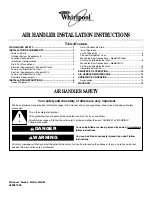
14
SEQUENCE OF OPERATION
Cooling (cooling only or heat pump)
When the thermostat calls for cooling, the circuit between R and
G is completed, and the blower relay is energized. The Normally
Open contacts close, causing the indoor blower motor to
operate. The circuit between R and Y is also completed; this
circuit closes the contactor in the outdoor unit starting the
compressor and outdoor fan motor. Circuit R and O energizes the
reversing valve, switching it to the cooling position. (The
reversing valve remains energized as long as selector switch is in
the COOL position.)
Heating (electric heat only)
When the thermostat calls for heat, the circuit between R and W
is completed, and the heater sequencer is energized. A time
delay follows before the heating elements and the indoor blower
motor come on. Units with a second heat sequencer can be
connected with the first sequencer to W on the thermostat
subbase or connected to a second stage on the subbase.
Heating (heat pump)
When the thermostat calls for heat, the circuits between R and Y
and R and G are completed. Circuit R-Y energizes the contactor
starting the outdoor fan motor and the compressor. Circuit R and
G energizes the blower relay starting the indoor blower motor.
If the room temperature should continue to fall, the circuit
between R and W 1 is completed by the second stage heat room
thermostat. Circuit R-W 1 energizes a heat sequencer. The
completed circuit will energize supplemental electric heat (if
applicable). Units with a second heater sequencer can be
connected with the first sequencer to W 1 on the thermostat or
connected to a second heating stage W 2 on the thermostat
subbase.
Emergency Heat (heating heat pump)
If selector switch on thermostat is set to the emergency heat
position, the heat pump will be locked out of the heating circuit,
and all heating will be electric heat (if applicable). A jumper
should be placed between W 2 and E on the thermostat subbase
so that the electric heat control will transfer to the first stage heat
on the thermostat. This will allow the indoor blower to cycle on
and off with the electric heat when the fan switch is in the AUTO
position.
AIR HANDLER MAINTENANCE
IMPORTANT: Do not operate system without a filter. A filter is
required to protect the coil, blower, and internal parts from
excessive dirt and dust. See “Installation Configurations” for the
location of the filter in the unit cabinet and the service panel
giving access to unit filter. The filter is placed in the supply air
return duct by the installer.
■
Inspect air filters at least once a month and replace or clean
as required. Dirty filters are the most common cause of
inadequate heating or cooling performance.
■
Replace disposable filters. Cleanable filters can be cleaned
by soaking in mild detergent and rinsing with cold water.
■
Install new/clean filters with the arrows on the side pointing in
the direction of airflow.
■
Do not replace a cleanable (high velocity) filter with a
disposable (low velocity) filter unless return air system is
properly sized for it.
■
If water should start coming from the secondary drain line, a
problem exists which should be investigated and corrected.
Contact a qualified person.
ASSISTANCE OR SERVICE
If you need further assistance, you can write to the below
address with any questions or concerns:
Whirlpool
®
Home Cooling and Heating
317 S. North Lake Blvd.
Altomonte Springs, FL 32701
Please include a daytime phone number in your correspondence.
Accessories
Electric Heat Kits
Refer to the accessory kit label on the front panel of the air
handler for electric heat kit accessory options and applications.
Horizontal Drain Pan Kit
Consult with your distributor to obtain the part number for this kit.
Содержание WAHM
Страница 15: ...15 ...

























